Enthusiast Interviews
Enthusiast Interviews
For some time, we've always wanted to post interviews with some of our diverse clientele who come from different walks of life around the globe. While some may not be interested in a discussion about particular military vehicles, motorcycles or aircraft, the intent is to showcase each person's background, along with their particular outlook on the diecast industry at-large. If you would like to be included in these exposes, feel free to contact us so we can explore the opportunities further.
John Kenny, Lieutenant (O-3), USN, Captain (O-3), ANG (ret)
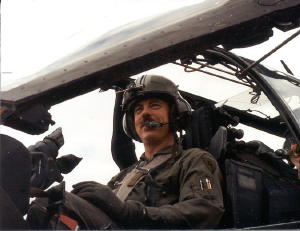 Having been in business now for over a decade, we've always found that the most memorable moments have occurred when a fellow collector shares their personal stories and insights into what got them started collecting diecast memorabilia. Oftentimes, the hobby serves as an extension of their personal or professional lives, helping them relive past events, recollections or tales from a three-dimensional standpoint, no book, documentary or movie could ever hope to satisfy. In other instances, the hobby serves as a connection to the past, bringing back fond memories of sharing the build of a model with a warm-hearted journeyman.
Having been in business now for over a decade, we've always found that the most memorable moments have occurred when a fellow collector shares their personal stories and insights into what got them started collecting diecast memorabilia. Oftentimes, the hobby serves as an extension of their personal or professional lives, helping them relive past events, recollections or tales from a three-dimensional standpoint, no book, documentary or movie could ever hope to satisfy. In other instances, the hobby serves as a connection to the past, bringing back fond memories of sharing the build of a model with a warm-hearted journeyman.
In the first installment of our enthusiast interview series, we kick things off with our longtime customer, John Kenny, who has been an avid collector and friendly confidant for a number of years. John offers his own unique take on the hobby and how he pursues it given his diverse background.
The Motor Pool (TMP): John, could you please tell us about your professional background?
John Kenny (JK): I graduated from Marquette University in Milwaukee, Wisconsin with a Bachelor's Degree in Mechanical Engineering in 1966. I was commissioned an Ensign in the Navy at that time since I had been in Marquette's NROTC program and was selected for Naval Aviation. I received my Wings in June 1967 and was assigned to an East Coast helicopter squadron based at Lakehurst, New Jersey. HC-4 (Helicopter Combat Support Squadron Four) was operating the UH2A/B.
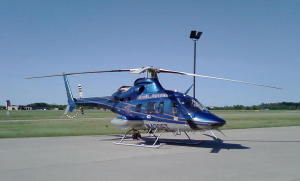 My first deployment was to Antarctica during Operation Deep Freeze 1967-68. My final assignment was OIC of HC-4 Detachment 36, which, oddly enough, operated from the USS Dubuque and later USS Cleveland based at Da Nang, Republic of Vietnam, as part of I Corps. I went inactive in 1970 and received a Master of Science degree at Rutgers University, in New Brunswick, New Jersey.
My first deployment was to Antarctica during Operation Deep Freeze 1967-68. My final assignment was OIC of HC-4 Detachment 36, which, oddly enough, operated from the USS Dubuque and later USS Cleveland based at Da Nang, Republic of Vietnam, as part of I Corps. I went inactive in 1970 and received a Master of Science degree at Rutgers University, in New Brunswick, New Jersey.
Jobs in research with birds, snakes and mammals were scarce, so I returned to my home town of Niles, Michigan. I indulged a lifelong interest in law enforcement, and was accepted by the Michigan State Police. Recruit school began in September 1972 and I reported to my first Post in December of that year. I worked the road for 14 years serving in the Michigan Army National Guard in their helicopter battalion at Grand Ledge, Michigan.
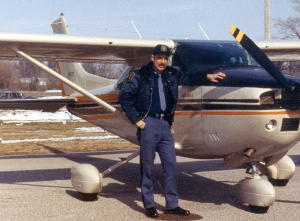 During my 21 years at Grand Ledge, we cycled through UH-1Hs, UM-1Ms (guns) and finally AH-1 Cobras (S and F models). In 1986, I was selected to fly for the Michigan State Police Aviation Unit, based in Lansing, Michigan. They've operated a good variety of aircraft over the years, including the Bell Jet and Long Rangers, Bell 222s and 430s, and Cessna 182s, 401s, 421s and 404s. I've had the good fortune to fly a great selection of aircraft on many very interesting and varied missions. I served as Chief Pilot from 1996 until my retirement in September of 2009.
During my 21 years at Grand Ledge, we cycled through UH-1Hs, UM-1Ms (guns) and finally AH-1 Cobras (S and F models). In 1986, I was selected to fly for the Michigan State Police Aviation Unit, based in Lansing, Michigan. They've operated a good variety of aircraft over the years, including the Bell Jet and Long Rangers, Bell 222s and 430s, and Cessna 182s, 401s, 421s and 404s. I've had the good fortune to fly a great selection of aircraft on many very interesting and varied missions. I served as Chief Pilot from 1996 until my retirement in September of 2009.
My wife and I live on a 90 acre retreat outside Sunfield, Michigan. Between her glassware and art collecting and my diecast, WW II firearms and memorabilia interests, not to mention our wildlife rehab and habitat improvement efforts, we are very busy. I also have a strong interest in military history, particularly the Civil War, the 1870s western cavalry, and WW II. My father served with the 12th Armored Division in Europe during the war which took severe casualties during the German assault known as Operation Nordwind. (Two good reads on the 12th: THE OTHER SIDE OF TIME by Brendon Phibbs, and CROSSING THE ZORN, by Edmond Monroe-Jones.) The 12th Armored Division website is also a good source for U S armored divisions in the ETO.
TMP: What got you started collecting diecast memorabilia?
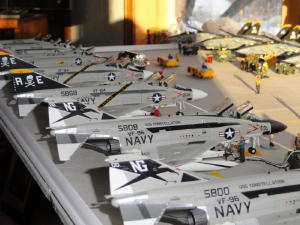 JK: For me, diecast collecting is a natural progression from model building, at least for those of us that don't have the time, patience, or eyesight to build the classic plastic model kits. My younger days were filled with Revell, Aurora and, most particularly, Monogram products. Once I got out into the real world, I kept up the interest but was not very active in the model building side of it. I even bought a couple of completed models from hobby shop displays. The first actual 'diecast' (evidently, plastic somehow morphed into metal along the way!) completed aircraft I bought was 21st Century Toys' first issue P-38 in 1/18th scale. I collected quite a few of the 1/18th aircraft before space, especially for display, became an issue. I had been dabbling in some of the Dragon 1/72 panzers and decided to try their F-14 in 'Sundowners' livery. The shift to the smaller scale aircraft made sense, especially for dioramas and multiple aircraft displays. Once Century Wings and Hobby Master entered the scene, I shifted almost exclusively to 1/72 for both vehicles and aircraft.
JK: For me, diecast collecting is a natural progression from model building, at least for those of us that don't have the time, patience, or eyesight to build the classic plastic model kits. My younger days were filled with Revell, Aurora and, most particularly, Monogram products. Once I got out into the real world, I kept up the interest but was not very active in the model building side of it. I even bought a couple of completed models from hobby shop displays. The first actual 'diecast' (evidently, plastic somehow morphed into metal along the way!) completed aircraft I bought was 21st Century Toys' first issue P-38 in 1/18th scale. I collected quite a few of the 1/18th aircraft before space, especially for display, became an issue. I had been dabbling in some of the Dragon 1/72 panzers and decided to try their F-14 in 'Sundowners' livery. The shift to the smaller scale aircraft made sense, especially for dioramas and multiple aircraft displays. Once Century Wings and Hobby Master entered the scene, I shifted almost exclusively to 1/72 for both vehicles and aircraft.
TMP: Which manufacturer's products do you enjoy collecting the most?
JK:: Century Wings, Hobby Master and Dragon are my favorite manufacturers.
TMP: What types of products do you collect and what are your preferred scales?
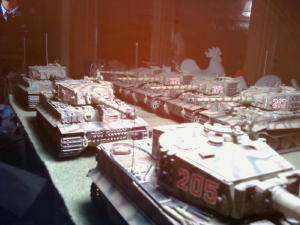 JK: I prefer 1/72 scale for the convenient size although still large enough to allow respectable detail. My ground collection is mainly WW II -- U.S. and German (with some Russian tanks for Eastern Front work) -- from both Dragon and Hobby Master. In the air, my favorites are the Century Wings products, the F-14 in particular, and Hobby Master, with their excellent F-4 and A-1 series.
JK: I prefer 1/72 scale for the convenient size although still large enough to allow respectable detail. My ground collection is mainly WW II -- U.S. and German (with some Russian tanks for Eastern Front work) -- from both Dragon and Hobby Master. In the air, my favorites are the Century Wings products, the F-14 in particular, and Hobby Master, with their excellent F-4 and A-1 series.
TMP: What do you consider to be the most important attributes found in any diecast collectible?
JK: To me, the most important feature of a collection is how it fits the interests and goals of the individual hobbyist. A small flight deck or tank diorama is just as important to an apartment dweller as a 4-foot tarmac scene to somebody with more space. If you collect to get one of each and leave them undisturbed in their packaging, that's great. If you want to super-detail and have a flight of four display, that's fine too. Whatever makes the collector happy, I believe, is most important.
TMP: How do you display your collectibles?
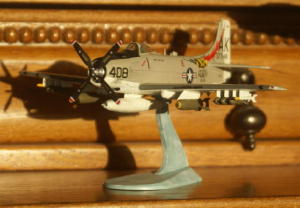 JK: Probably 30% of my 1/72 collection is displayed on shelves in my hobby room in the basement. I also have a 2 x 4 foot concrete board anchored to the table next to my recliner in the living room, and, depending on my focus at the moment (usually based on current events or my newest acquisition), it serves as a portion of a carrier deck, a tank park, or a stretch of battleground for the armor. I have artificial grass and lots of accessories to fine tune the scene. In the past few days, I've gone to the airbase ready ramp mode and brought up the F-22s.
JK: Probably 30% of my 1/72 collection is displayed on shelves in my hobby room in the basement. I also have a 2 x 4 foot concrete board anchored to the table next to my recliner in the living room, and, depending on my focus at the moment (usually based on current events or my newest acquisition), it serves as a portion of a carrier deck, a tank park, or a stretch of battleground for the armor. I have artificial grass and lots of accessories to fine tune the scene. In the past few days, I've gone to the airbase ready ramp mode and brought up the F-22s.
TMP: Do you see yourself ever selling off part or all of your collection?
JK: I have been selling off the 1/18th stuff. It's a matter of the large amount of space required to display them. I prefer to reinvest that capital into more of the 1/72 items now becoming available.
TMP: Do you prefer to collect replicas from a particular historical period or are you open to multiple eras?
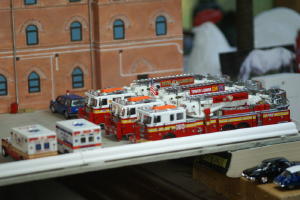 JK: I'm flexible regarding the time frame of a particular piece of equipment. If I like the item, I'll get it. However, WW II, Vietnam and subsequent periods are my main areas of focus. If I'm weak in any areas, they are WW I and Korea. I forgot to mention that I have a strong Code 3 FDNY collection in 1/64 as well.
JK: I'm flexible regarding the time frame of a particular piece of equipment. If I like the item, I'll get it. However, WW II, Vietnam and subsequent periods are my main areas of focus. If I'm weak in any areas, they are WW I and Korea. I forgot to mention that I have a strong Code 3 FDNY collection in 1/64 as well.
TMP: What turns you off about collecting diecast? (Pricing, long wait periods, products that don't live up to their billing, shoddy customer service, etc.)
JK: I've been in the diecast game long enough that I've become pretty flexible regarding frustrations, etc. Of course, getting a damaged item, particularly one that has been long anticipated, is a bit discouraging. It doesn't happen very often, and you personally have been great in squaring away the problems. But I have the suspicion that once the product leaves the Pacific Rim, there is no quality control. Since a lot of the aircraft, in particular, have an outer box lid hinged and Velcro-ed to the clear windowed box, I would think a quick peek inside, especially if there is that ominous rattling sound, would be good quality control.
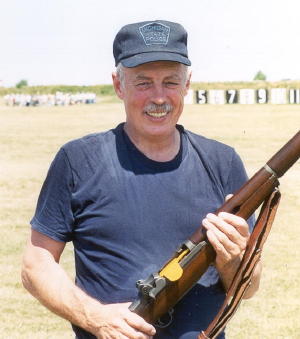 The only other thing that I'd like to mention is the inconsistency of the various manufacturers' interpretations of 1/72 scale. This is particularly true with aircrew figures -- we've got giants and midgets out there. Century Wings (CW) seems to spec out closest to the real scale, and their pilots aren't dwarfed by their ships, although even CW tends to have the crew sitting too low in the seat. I've built seat cushions for every jet I've bought (except the F-8 and A-7) from any manufacturer. Just talk to Roger Ramjet. Those pukes are up as high as they can sit in the seat (except for some emergencies, of course). On the ground vehicle side, there's a serious scale problem with the recent Unimax trucks. They are monsters.
The only other thing that I'd like to mention is the inconsistency of the various manufacturers' interpretations of 1/72 scale. This is particularly true with aircrew figures -- we've got giants and midgets out there. Century Wings (CW) seems to spec out closest to the real scale, and their pilots aren't dwarfed by their ships, although even CW tends to have the crew sitting too low in the seat. I've built seat cushions for every jet I've bought (except the F-8 and A-7) from any manufacturer. Just talk to Roger Ramjet. Those pukes are up as high as they can sit in the seat (except for some emergencies, of course). On the ground vehicle side, there's a serious scale problem with the recent Unimax trucks. They are monsters.
TMP: Where do you see the hobby headed for the foreseeable future?
JK: I think that detail and subject matter will only get better. Of course, there is a price for that, so I'm guessing that volume of sales may go down. As you well know, I've always had the fetish, as it were, to buy two of each aircraft at the minimum; one for flight mode and the other for the ramp. Not so much anymore! And my flights of two (and in some cases, four) have probably seen their day as well.
TMP: Very enlightening comments, John. Many thanks for the time you took to respond to these questions and we wish you much luck and success pursuing this fantastic hobby.





 Having been in business now for over a decade, we've always found that the most memorable moments have occurred when a fellow collector shares their personal stories and insights into what got them started collecting diecast memorabilia. Oftentimes, the hobby serves as an extension of their personal or professional lives, helping them relive past events, recollections or tales from a three-dimensional standpoint, no book, documentary or movie could ever hope to satisfy. In other instances, the hobby serves as a connection to the past, bringing back fond memories of sharing the build of a model with a warm-hearted journeyman.
Having been in business now for over a decade, we've always found that the most memorable moments have occurred when a fellow collector shares their personal stories and insights into what got them started collecting diecast memorabilia. Oftentimes, the hobby serves as an extension of their personal or professional lives, helping them relive past events, recollections or tales from a three-dimensional standpoint, no book, documentary or movie could ever hope to satisfy. In other instances, the hobby serves as a connection to the past, bringing back fond memories of sharing the build of a model with a warm-hearted journeyman.
 My first deployment was to Antarctica during Operation Deep Freeze 1967-68. My final assignment was OIC of HC-4 Detachment 36, which, oddly enough, operated from the USS Dubuque and later USS Cleveland based at Da Nang, Republic of Vietnam, as part of I Corps. I went inactive in 1970 and received a Master of Science degree at Rutgers University, in New Brunswick, New Jersey.
My first deployment was to Antarctica during Operation Deep Freeze 1967-68. My final assignment was OIC of HC-4 Detachment 36, which, oddly enough, operated from the USS Dubuque and later USS Cleveland based at Da Nang, Republic of Vietnam, as part of I Corps. I went inactive in 1970 and received a Master of Science degree at Rutgers University, in New Brunswick, New Jersey.
 During my 21 years at Grand Ledge, we cycled through UH-1Hs, UM-1Ms (guns) and finally AH-1 Cobras (S and F models). In 1986, I was selected to fly for the Michigan State Police Aviation Unit, based in Lansing, Michigan. They've operated a good variety of aircraft over the years, including the Bell Jet and Long Rangers, Bell 222s and 430s, and Cessna 182s, 401s, 421s and 404s. I've had the good fortune to fly a great selection of aircraft on many very interesting and varied missions. I served as Chief Pilot from 1996 until my retirement in September of 2009.
During my 21 years at Grand Ledge, we cycled through UH-1Hs, UM-1Ms (guns) and finally AH-1 Cobras (S and F models). In 1986, I was selected to fly for the Michigan State Police Aviation Unit, based in Lansing, Michigan. They've operated a good variety of aircraft over the years, including the Bell Jet and Long Rangers, Bell 222s and 430s, and Cessna 182s, 401s, 421s and 404s. I've had the good fortune to fly a great selection of aircraft on many very interesting and varied missions. I served as Chief Pilot from 1996 until my retirement in September of 2009.
 JK: For me, diecast collecting is a natural progression from model building, at least for those of us that don't have the time, patience, or eyesight to build the classic plastic model kits. My younger days were filled with Revell, Aurora and, most particularly, Monogram products. Once I got out into the real world, I kept up the interest but was not very active in the model building side of it. I even bought a couple of completed models from hobby shop displays. The first actual 'diecast' (evidently, plastic somehow morphed into metal along the way!) completed aircraft I bought was 21st Century Toys' first issue P-38 in 1/18th scale. I collected quite a few of the 1/18th aircraft before space, especially for display, became an issue. I had been dabbling in some of the Dragon 1/72 panzers and decided to try their F-14 in 'Sundowners' livery. The shift to the smaller scale aircraft made sense, especially for dioramas and multiple aircraft displays. Once Century Wings and Hobby Master entered the scene, I shifted almost exclusively to 1/72 for both vehicles and aircraft.
JK: For me, diecast collecting is a natural progression from model building, at least for those of us that don't have the time, patience, or eyesight to build the classic plastic model kits. My younger days were filled with Revell, Aurora and, most particularly, Monogram products. Once I got out into the real world, I kept up the interest but was not very active in the model building side of it. I even bought a couple of completed models from hobby shop displays. The first actual 'diecast' (evidently, plastic somehow morphed into metal along the way!) completed aircraft I bought was 21st Century Toys' first issue P-38 in 1/18th scale. I collected quite a few of the 1/18th aircraft before space, especially for display, became an issue. I had been dabbling in some of the Dragon 1/72 panzers and decided to try their F-14 in 'Sundowners' livery. The shift to the smaller scale aircraft made sense, especially for dioramas and multiple aircraft displays. Once Century Wings and Hobby Master entered the scene, I shifted almost exclusively to 1/72 for both vehicles and aircraft.
 JK: I prefer 1/72 scale for the convenient size although still large enough to allow respectable detail. My ground collection is mainly WW II -- U.S. and German (with some Russian tanks for Eastern Front work) -- from both Dragon and Hobby Master. In the air, my favorites are the Century Wings products, the F-14 in particular, and Hobby Master, with their excellent F-4 and A-1 series.
JK: I prefer 1/72 scale for the convenient size although still large enough to allow respectable detail. My ground collection is mainly WW II -- U.S. and German (with some Russian tanks for Eastern Front work) -- from both Dragon and Hobby Master. In the air, my favorites are the Century Wings products, the F-14 in particular, and Hobby Master, with their excellent F-4 and A-1 series.
 JK: Probably 30% of my 1/72 collection is displayed on shelves in my hobby room in the basement. I also have a 2 x 4 foot concrete board anchored to the table next to my recliner in the living room, and, depending on my focus at the moment (usually based on current events or my newest acquisition), it serves as a portion of a carrier deck, a tank park, or a stretch of battleground for the armor. I have artificial grass and lots of accessories to fine tune the scene. In the past few days, I've gone to the airbase ready ramp mode and brought up the F-22s.
JK: Probably 30% of my 1/72 collection is displayed on shelves in my hobby room in the basement. I also have a 2 x 4 foot concrete board anchored to the table next to my recliner in the living room, and, depending on my focus at the moment (usually based on current events or my newest acquisition), it serves as a portion of a carrier deck, a tank park, or a stretch of battleground for the armor. I have artificial grass and lots of accessories to fine tune the scene. In the past few days, I've gone to the airbase ready ramp mode and brought up the F-22s.
 JK: I'm flexible regarding the time frame of a particular piece of equipment. If I like the item, I'll get it. However, WW II, Vietnam and subsequent periods are my main areas of focus. If I'm weak in any areas, they are WW I and Korea. I forgot to mention that I have a strong Code 3 FDNY collection in 1/64 as well.
JK: I'm flexible regarding the time frame of a particular piece of equipment. If I like the item, I'll get it. However, WW II, Vietnam and subsequent periods are my main areas of focus. If I'm weak in any areas, they are WW I and Korea. I forgot to mention that I have a strong Code 3 FDNY collection in 1/64 as well.
 The only other thing that I'd like to mention is the inconsistency of the various manufacturers' interpretations of 1/72 scale. This is particularly true with aircrew figures -- we've got giants and midgets out there. Century Wings (CW) seems to spec out closest to the real scale, and their pilots aren't dwarfed by their ships, although even CW tends to have the crew sitting too low in the seat. I've built seat cushions for every jet I've bought (except the F-8 and A-7) from any manufacturer. Just talk to Roger Ramjet. Those pukes are up as high as they can sit in the seat (except for some emergencies, of course). On the ground vehicle side, there's a serious scale problem with the recent Unimax trucks. They are monsters.
The only other thing that I'd like to mention is the inconsistency of the various manufacturers' interpretations of 1/72 scale. This is particularly true with aircrew figures -- we've got giants and midgets out there. Century Wings (CW) seems to spec out closest to the real scale, and their pilots aren't dwarfed by their ships, although even CW tends to have the crew sitting too low in the seat. I've built seat cushions for every jet I've bought (except the F-8 and A-7) from any manufacturer. Just talk to Roger Ramjet. Those pukes are up as high as they can sit in the seat (except for some emergencies, of course). On the ground vehicle side, there's a serious scale problem with the recent Unimax trucks. They are monsters.